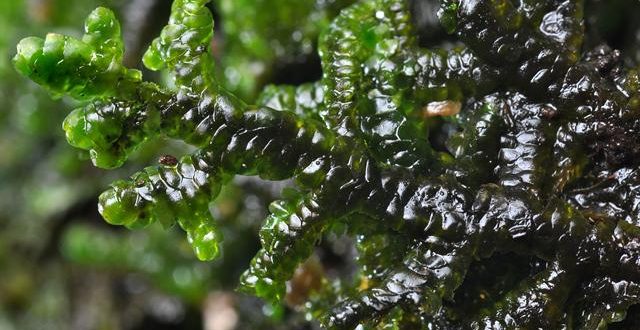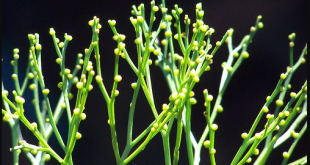Systematic Position
Division : Bryophyta
Class : Hepaticopsida
Order : Jungermanniales
Family : Porallaceae
Genus : Porella

Habit And Habitat
Best safe and secure cloud storage with password protection
Get Envato Elements, Prime Video, Hotstar and Netflix For Free
Best Money Earning Website 100$ Day
#1 Top ranking article submission website
Porella the only genus of the family prellaceae, grows in temperate and tropical regions, mainly in the hills. A total of 184 species have been identified. They grow in moist, shady places, on bark of trees, rocks, etc. It is found everywhere, except in the Artic and Antatic regions. They grow to about 15 cm in height. In most cases the plant is pinnate and dark or black green. The leaves of the plants of this genus are divided into two oval or round lobes. The upper lobe is bigger than the lower lobes, which is smaller or of about the same size as the round or oval underleaves. Leaves act as main absorptive organs whereas the number of rhizoids and cells of stems act as additional absorptive organs. The main function of the rhizoids is to anchor the plant with substratum.
Internal Features
- Axis: Epidermis is not well differentiated. Cortex consists of small thick walled cells. The cells of the central portion are large and thin walled. Leaves have simplest organization and consist of single layer of isometric-polygonal cells with abundant chloroplasts in each cell.
- Apical growth: By a single tetrahedral apical cell with 3 cutting faces.
Plant body: Gametophyte
- Thallus: leafy axis, dorsiventral and prostrate.
- Branching: Monopodial, terminal.
- Rhizoids: Unicellular, unbranched and smooth walled.
- Scales: Absent.
- Leaves arrangement: In 3 rows, 2 rows of dorsal leaves, 1 row of ventral leaves(under leaves). All cells alike and unistratose.
Reproduction
- Plants are dioecious.
- Antheridia – male sex organ: Axillary and present on special antheridial branch.
- Stalk : Long and 2 cells broad.
- Jacket: 2-3 cells thick in the basal part and single layer in the upper part.
- Archegonia- female sex organ: Present on the tip of special archegonial branch.
- Neck: Consists of 5 vertical rows of cells.
- Neck canal cells: 6-8.
- Cover cells : 4.
- Venter: Two layered.
Vegetative reproduction
Death And Decay: The basal older parts of the thallus die and decay. It separates the branches. These branches grow and become independent plant.
Discord Gemmae: These gemmae consist of only one or two cells. They are formed on leaf margin.
Tubers: These are modified special underground branches. These are formed at the end of growing season. They remain dormant throughout the unfavorable condition.
Sexual Reproduction
Development of antheridium in porella
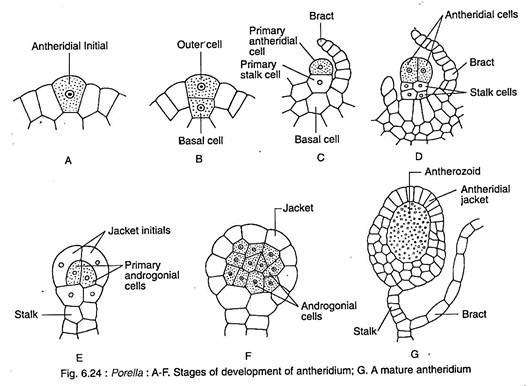
Development of archegnium in porella

The plants are either monoecious or dioecious, and the sex organs are borne on short lateral branches together with the bracts.
Each antheridium is borne in the axil of a leaf of an antheridial branch. A mature antheridium is more or less globose with a long stalk. The jacket of the antheridium is one cell in thickness except at the apical region. Antherozoids are typically biflagellate and crescent-shaped.
The archegonial branches are shorter than those of the antheridial ones and bear archegonia at their apices in groups. They are surrounded by a rosette of modified enlarged leaves. An archegonium develops from the apical cell, thereby checking further growth of the branch.
A mature archegonium has a broad venter containing a ventral canal cell and an egg. The wall of the venter is more than one cell in thickness. The neck is long and contains 6-8 neck canal cells. Each group of mature archegonia is surrounded by a thin sheath developed from the archegonial branch. This sheath is termed as marsupium.
The gametic union requires the presence of sufficient water. The antherozoids are carried by the current of water near the archegonium, one of which ultimately unites with the egg, thereby, effecting fertilization. With fertilization and formation of oospore, sporophytic or diploid generation begins.
The Sporophyte of Porella
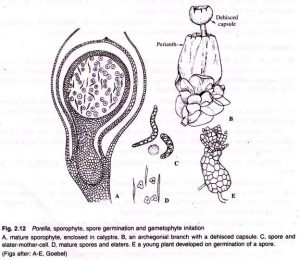
The oospore, produced as a result of fertilization, divides transversely into a hypobasal cell and an epibasal cell. The hypobasal cell produces a haustorium of two or more cells. The rest of the sporophyte develops entirely from the epibasal cell.
A mature sporophyte has a foot, a seta and a capsule. The foot is bulbous, the seta is short and the capsule is large and globose. The jacket of the capsule is more than one cell in thickness. The cells of the outermost layer are thick- walled, except along the four vertical lines which form the future lines of dehiscence of the capsule. The jacket develops from the amphithecium.
The endothecium forms the sporogenous tissue. Certain portion of the sporogenous tissue is fertile and by reduction division forms the spore tetrads, while the rest are sterile and develop into elaters.
The spores may be brown or golden brown in colour and in many cases, they may be winged. With reduction division and formation of spores, the gametophytic or haploid generation begins. The elaters may be branched or unbranched.
A mature sporophyte is protected by the marsupium, perianth (formed by the bracts of the archegonium) and the multi-layered calyptra (formed from the venter).
The mature capsule, prior to dehiscence, is carried up beyond the calyptra, perianth and marsupium by the sudden elongation of the seta. The capsule then splits from apex downwards along the four vertical lines of dehiscence. The dehiscence is mainly due to the hygroscopic movements of the elaters.
The New Gametophyte of Porella
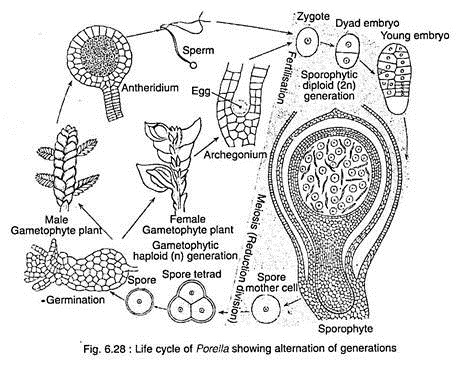
The spores, falling upon suitable substratum, germinate to produce new gametophytes.
Best safe and secure cloud storage with password protection
Get Envato Elements, Prime Video, Hotstar and Netflix For Free
 Plantlet The Blogging Platform of Department of Botany, University of Dhaka
Plantlet The Blogging Platform of Department of Botany, University of Dhaka
